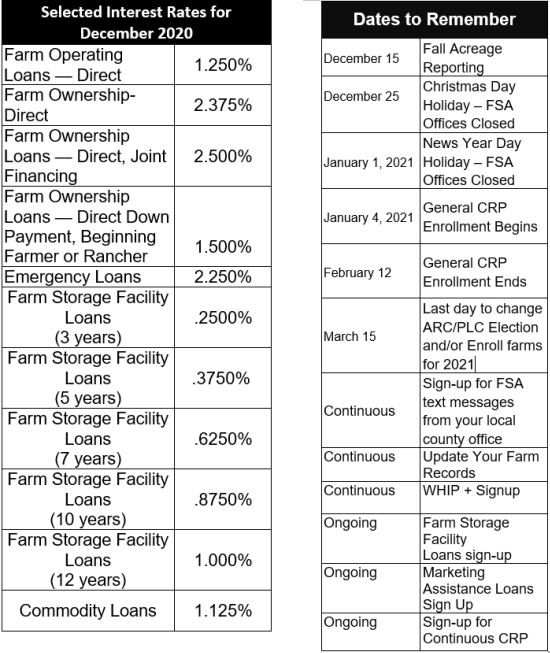|
 Christmas is right around the corner, and I want to wish each
and every one of you a Merry Christmas. Years like this is
exactly what Christmas is for. Christmas is right around the corner, and I want to wish each
and every one of you a Merry Christmas. Years like this is
exactly what Christmas is for.
May 2021 be a better year for you and yours, and wish you all
good health and wellness!
William Graff
Getting Started with FSA
First you want to make sure your farm is registered. If you
purchased land, it may already be established with USDA's Farm
Service Agency (FSA) with a farm number on file. If not FSA can
help you register your farm.
To obtain a farm number, you will bring in an official Tax ID
(Social Security number or Employer ID) and a property deed.
If you do not own the land, bring a lease agreement to show you
have control of the property to your FSA representative.
If your operation is incorporated or an entity, you may also
need to provide proof that you have signature authority and the
legal ability to enter contracts with USDA.

Policy Updates for Acreage Reporting
The USDA Farm Service Agency (FSA) reminds Illinois agricultural
producers to complete crop acreage reports by the December 15,
2020, deadline for fall-seeded small grains. In order to
maintain program eligibility and benefits, you must timely file
acreage reports. Failure to file an acreage report by the crop
acreage reporting deadline may result in ineligibility for
future program benefits. FSA will not accept acreage reports
provided more than a year after the acreage reporting deadline.
Recently, the USDA Farm Service Agency (FSA) made several policy
updates for acreage reporting for cover crops, revising intended
use, late-filed provisions, grazing allotments as well as
updated the definitions of “idle” and “fallow.”
Reporting Cover Crops:
Cover crop types can be chosen from the following four
categories:
-
Cereals and
other grasses
-
Legumes
-
Brassicas
and other broadleaves
-
Mixtures
-
If the cover
crop is harvested for any use other than forage or grazing
and is not terminated according to policy guidelines, then
that crop will no longer be considered a cover crop and the
acreage report must be revised to reflect the actual crop.
Permitted Revision of Intended use After Acreage Reporting
Date:
New operators or owners who pick up a farm after the acreage
reporting deadline has passed and the crop has already been
reported on the farm, have 30 calendar days from the date when
the new operator or owner acquired the lease on land, control of
the land or ownership and new producer crop share interest in
the previously reported crop acreage. Under this policy,
appropriate documentation must be provided to the County
Committee’s satisfaction to determine that a legitimate operator
or ownership and producer crop share interest change occurred to
permit the revision.
Reporting Grazing Allotments:
FSA offices can now accept acreage reports for grazing
allotments. You will use form “FSA-578” to report grazing
allotments as animal unit months (AUMs) using the “Reporting
Unit” field. Your local FSA office will need the grazing period
start and end date and the percent of public land.
Definitions of Terms
FSA defines “idle” as cropland or a balance of cropland within a
Common Land Unit (CLU) (field/subfield) which is not planted or
considered not planted and does not meet the definition of
fallow or skip row.
Fallow is considered unplanted cropland acres which are part of
a crop/fallow rotation where cultivated land that is normally
planted is purposely kept out of production during a regular
growing season.
For more information, contact your local County USDA Service
Center or visit fsa.usda.gov
Applying for FSA Direct Loans
FSA offers direct farm ownership and direct farm operating loans
to producers who want to establish, maintain, or strengthen
their farm or ranch. Direct loans are processed, approved and
serviced by FSA loan officers.
Direct farm operating loans can be used to purchase livestock
and feed, farm equipment, fuel, farm chemicals, insurance, and
other costs including family living expenses. Operating loans
can also be used to finance minor improvements or repairs to
buildings and to refinance some farm-related debts, excluding
real estate.
Direct farm ownership loans can be used to purchase farmland,
enlarge an existing farm, construct and repair buildings, and to
make farm improvements.
The maximum loan amount for direct farm ownership loans is
$600,000 and the maximum loan amount for direct operating loans
is $400,000 and a down payment is not required. Repayment terms
vary depending on the type of loan, collateral and the
producer's ability to repay the loan. Operating loans are
normally repaid within seven years and farm ownership loans are
not to exceed 40 years.
Please contact your local FSA office for more information or to
apply for a direct farm ownership or operating loan.
Applying for FSA Guaranteed Loans
FSA guaranteed loans allow lenders to provide agricultural
credit to farmers who do not meet the lender's normal
underwriting criteria. Farmers and ranchers apply for a
guaranteed loan through a lender, and the lender arranges for
the guarantee. FSA can guarantee up to 95 percent of the loss of
principal and interest on a loan. Guaranteed loans can be used
for both farm ownership and operating purposes.
Guaranteed farm ownership loans can be used to purchase
farmland, construct or repair buildings, develop farmland to
promote soil and water conservation or to refinance debt.
Guaranteed operating loans can be used to purchase livestock,
farm equipment, feed, seed, fuel, farm chemicals, insurance and
other operating expenses.
FSA can guarantee farm ownership and operating loans up to
$1,776,000. Repayment terms vary depending on the type of loan,
collateral and the producer's ability to repay the loan.
Operating loans are normally repaid within seven years and farm
ownership loans are not to exceed 40 years.
For more information on guaranteed loans, contact your local
County USDA Service Center or visit fsa.usda.gov.
USDA Announces Implementation of
Improvements to Prevented Planting Coverage and the Beginning
and Veteran Farmer and Rancher Program
The U.S. Department of Agriculture’s (USDA) Risk Management
Agency (RMA) announced that improvements to prevented planting
coverage and to the beginning and veteran farmer and rancher
program took effect on November 30 for crop year 2021. These
improvements, among others, were made to the Common Crop
Insurance Policy Basic Provisions.
These improvements are the result of feedback from producer
groups and other stakeholders. These changes will improve
prevented planting coverage and the beginning and veteran farmer
and rancher program for years to come.
Improvements to prevented planting coverage include:
-
Expanding
the “1 in 4” requirement nationwide, requiring producers to
plant, insure and harvest acreage in at least one of the
four most recent crop years.
-
Making
modifications to ensure that producers’ prevented planting
payments adequately reflect the crops the producer intended
to plant.
-
For more
information, see the previous announcement.
The improvement to the beginning and veteran
farmer and rancher program will allow participants with farming
experience to use the Actual Production History (APH) of the
previous producer, with permission, on newly acquired land.
Previously, the APH could only be used if the beginning or
veteran farmer or rancher was involved on the specific acreage
acquired.
RMA is authorizing additional flexibilities due to coronavirus
while continuing to support producers, working through Approved
Insurance Providers (AIPs) to deliver services, including
processing policies, claims and agreements. RMA staff are
working with AIPs and other customers by phone, mail and
electronically to continue supporting crop insurance coverage
for producers. Farmers with crop insurance questions or needs
should continue to contact their insurance agents about
conducting business remotely (by telephone or email). More
information can be found at farmers.gov/coronavirus.
Crop insurance is sold and delivered solely through private
insurance agents. A list of insurance agents is available online
using the RMA Agent Locator. Learn more about crop insurance and
the modern farm safety net at rma.usda.gov.
2019 Crop Year ARC and PLC Payments
FSA began processing payments in October for 2019 ARC-County
(ARC-CO) and PLC on covered commodities that met payment
triggers on farms enrolled for the 2019 crop year. In addition
to the $6 billion now in process, FSA anticipates it will issue
additional payments by the end of December for 2019 commodities
covered under ARC-Individual (ARC-IC).
Producers who had 2019 covered commodities enrolled in ARC-CO
can visit the ARC and PLC webpage for payment rates applicable
to their county and each covered commodity. For farms and
covered commodities enrolled in 2019 PLC, the following crops
met payment triggers: barley, canola, chickpeas (small and
large), corn, dry peas, flaxseed, grain sorghum, lentils, long
and medium grain rice, peanuts, rapeseed, safflower, seed
cotton, sunflower seed, and wheat.
Crambe, mustard seed, oats, sesame seed, and soybeans did not
meet 2019 PLC payment triggers.
Web-Based Decision Tools
In partnership with USDA, the University of Illinois and Texas
A&M University offer web-based decision tools to assist
producers in making informed, educated decisions using crop data
specific to their respective farming operations.
Tools include:
-
Gardner-farmdoc Payment Calculator, the University of
Illinois tool that offers farmers the ability to run payment
estimate modeling for their farms and counties for
ARC-County and PLC.
-
ARC and PLC
Decision Tool, the Texas A&M tool allows producers to
analyze payment yield updates and expected payments for
2021. Producers who have used the tool in the past should
see their username and much of their farm data already
available in the system.
More Information
For more information on ARC and PLC, including two online
decision tools that assist producers in making enrollment and
election decisions specific to their operations, visit the ARC
and PLC webpage.
For additional questions and assistance, contact your local USDA
service center. To locate your local FSA office, visit
farmers.gov/service-locator.
Farm Storage Facility Loan Program
FSA’s Farm Storage Facility Loan (FSFL) program provides
low-interest financing to producers to build or upgrade storage
facilities and to purchase portable (new or used) structures,
equipment and storage and handling trucks.
The low-interest funds can be used to build or upgrade permanent
facilities to store commodities. Eligible commodities include
corn, grain sorghum, rice, soybeans, oats, peanuts, wheat,
barley, minor oilseeds harvested as whole grain, pulse crops
(lentils, chickpeas and dry peas), hay, honey, renewable
biomass, fruits, nuts and vegetables for cold storage
facilities, floriculture, hops, maple sap, rye, milk, cheese,
butter, yogurt, meat and poultry (unprocessed), eggs, and
aquaculture (excluding systems that maintain live animals
through uptake and discharge of water). Qualified facilities
include grain bins, hay barns and cold storage facilities for
eligible commodities.
Loans up to $50,000 can be secured by a
promissory note/security agreement and loans between $50,000 and
$100,000 may require additional security. Loans exceeding
$100,000 require additional security.
Producers do not need to demonstrate the lack of commercial
credit availability to apply. The loans are designed to assist a
diverse range of farming operations, including small and
mid-sized businesses, new farmers, operations supplying local
food and farmers markets, non-traditional farm products, and
underserved producers.
[to top of second column] |

To learn more about the FSA Farm Storage Facility Loan, visit
www.fsa.usda.gov/pricesupport or contact your local FSA county
office. To find your local FSA county office, visit
http://offices.usda.gov.
Marketing Assistance Available for 2020 Crops
The 2018 Farm Bill extends loan authority through 2023 for Marketing
Assistance Loans (MALs) and Loan Deficiency Payments (LDPs).
MALs provide financing and marketing assistance for commodities such
as wheat, feed grains, soybeans and other oilseeds, pulse crops,
rice, wool and honey. MALs provide producers interim financing after
harvest to help them meet cash flow needs without having to sell
their commodities when market prices are typically at harvest-time
lows.
A producer who is eligible to obtain a MAL, but agrees to forgo the
loan, may obtain an LDP if such a payment is available.
To be eligible for a MAL, producers must have a beneficial interest
in the commodity, in addition to other requirements. A producer
retains beneficial interest when control of and title to the
commodity is maintained.
USDA to Open Signup for the Conservation Reserve
Program and CRP Grasslands in Early 2021
USDA today announced the 2021 signup periods for general
Conservation Reserve Program (CRP) and CRP Grasslands offers.
General signup for CRP will be open from January 4, 2021 to February
12, 2012; signup for CRP Grasslands runs from March 15, 2021 to
April 23, 2021. Both programs are competitive and provide annual
rental payments for land devoted to conservation purposes.
CRP and the many focused programs that come under it, like CRP
Grasslands, are some of the most critical tools to help producers
better manage their operations while conserving natural resources.
CRP has proven to protect the Nation’s valuable resources. Next
year’s signup gives farmers and ranchers an opportunity to enroll in
CRP for the first time or continue their participation for another
term.
Producers may apply by contacting their local county FSA office.
NRCS Announces Program Deadlines for 2021
Illinois Natural Resources Conservation Service (NRCS) recently
announced several programs, including statewide and specific
regions, with early January application deadlines. Illinois NRCS set
Jan. 8 as the application deadline for the Environmental Quality
Incentives Program (EQIP). EQIP provides financial and technical
assistance for agricultural and forested lands.

EQIP activities include installing structures for gully erosion,
improving pasture with inter-seeding and enhancing soil health with
cover crops. EQIP funds may also cover development of such plans as
a comprehensive nutrient management plan, grazing plan and drainage
water management plan.
Interested farmers should submit a signed application (NRCS-CPA-1200
form) to the local NRCS field office or via {Farmers.gov} using
their account. A blank NRCS-CPA-1200 application form is available
from a local NRCS office or the Illinois NRCS website {www.il.nrcs.usda.gov}.
Farmers may sign into their {Farmers.gov} account or create one by
clicking on “Sign up” in the upper right corner of the website.
Applications submitted by Jan. 8 will be evaluated by local NRCS
staff who will work with an applicant to assess land and resource
concerns, answer ranking questions and determine program
eligibility. Applications ranked high enough for funding will be
developed into a contract by NRCS staff and the farmer applicant.
In east-central Illinois, NRCS and Illinois Headwaters Conservation
Partnership will offer funding to control invasive plants in forest
stands through a Regional Conservation Partnership Program (RCPP).
The 11 participating counties include Champaign, Coles, Cumberland,
DeWitt, Douglas, Edgar, Ford, Iroquois, Livingston, Piatt and
Vermilion.
NRCS partnered with the Champaign County Soil and Water Conservation
District and the Headwaters Invasive Plant Partnership. Landowners
may apply for EQIP financial assistance to implement forest stand
improvement, brush management, herbaceous weed control and
tree/shrub establishment practices.
In lllinois’ Driftless Area, farmers in six northwestern counties
may apply to NRCS for funding to help improve fish and wildlife
habitat on cropland, forests, streams and prairies through an RCPP.
NRCS partnered with Trout Unlimited to address resource concerns.
Eligible landowners in portions of Boone, Carroll, Jo Daviess, Ogle,
Stephenson and Winnebago counties may apply through EQIP to
implement practices that include stream and shoreline protection,
cover crops and grassed waterways. The project focus is to reduce
soil erosion, improve water quality and improve wildlife
habitat.NRCS will offer funding in portions of Macoupin, Morgan and
Sangamon counties for the Otter Lake Source Water Protection project
through an RCPP. NRCS partnered with Illinois Corn Growers
Association to address degraded water quality and soil erosion.
Farmers whose land is in the Otter Lake Watershed may apply for EQIP
assistance to implement such practices as denitrifying bioreactors,
saturated buffers, cover crops, nutrient management and no-till.
As part of the Mississippi River Basin Initiative (MRBI) and the
National Water Quality Initiative (NWQI), land in targeted
watersheds may be eligible for special funding.
The following is a list of Initiatives including
the counties and watersheds where funding is available for 2021:
MRBI
-
Upper Macoupin
Creek – Portions of Macoupin County
-
Vermilion
Headwaters – Portions of Ford, Iroquois, Livingston, and McLean
Counties
NWQI
-
Lake Bloomington
– Money Creek Watershed – Portions of McLean County
-
Blue Mound –
Money Creek Watershed – Portions of McLean County
-
Lake Springfield
– Panther Creek Watershed – Portions of Sangamon County
To ensure consideration for all EQIP 2021 funding,
eligible farmers should submit a signed application (NRCS-CPA-1200
form) to the local NRCS field office or {Farmers.gov} by Jan. 8.
Blank forms are available from the local NRCS office or the Illinois
NRCS website. To check eligibility for any of the RCPP programs,
contact your local NRCS office or visit the Illinois NRCS website.
Maintaining the Quality of Farm-Stored Loan
Grain
Bins are ideally designed to hold a level volume of grain. When bins
are overfilled and grain is heaped up, airflow is hindered and the
chance of spoilage increases.
Producers who take out marketing assistance loans and use the
farm-stored grain as collateral should remember that they are
responsible for maintaining the quality of the grain through the
term of the loan.
Unauthorized Disposition of Grain
If loan grain has been disposed of through feeding, selling or any
other form of disposal without prior written authorization from the
county office staff, it is considered unauthorized disposition. The
financial penalties for unauthorized dispositions are severe and a
producer’s name will be placed on a loan violation list for a
two-year period. Always call before you haul any grain under loan.
Register for VIRTUAL 2021 Conservation Cropping
Seminars
Don’t miss information about ways farmers like yourself can improve
soil health, learn about cover crops, remain profitable—and even
more marketable—by using sustainable techniques that build up
natural resilience to weather extremes, pests, and weeds. Learn from
educators, researchers, experts, and local Illinois farmers! There
will be Question & Answer sessions as well. In keeping with state
mandates and safety precautions, we will offer helpful information,
new research and data, farmer testimonials, and more in three 2-hour
online virtual conference sessions. Dates & times:
Wed. Jan. 20 @ 9-11am
Thurs. Jan. 28 @ 9-11am
Thurs. Feb. 4 @ 9-11am
While it’s not our normal full-day, in-person get-together at three
different Illinois locations, the planning committee has gathered
some GREAT speakers and presentations that are well worth your time.
We can’t feed you lunch virtually, so for 2021, your participation
at the event is FREE—and lunch is “on your own”!
Scheduled speakers currently include:
Ray Archuleta, Certified Professional Soil Scientist with the Soil
Science Society of America
Dr. Joel Gruver, Western IL University, Associate Professor of Soil
Science and Sustainable Ag
Dr. Nic Jelinski, Asst. Professor at University of MN’s Department
of Soil, Water, and Climate
Illinois S.T.A.R. program coordinators & testimonials from farmer
participants
Dr. Stacy Zuber, IL NRCS Soil Health Specialist
The Peterson Farm Brothers
Don’t miss the 2021 event! Register online at the Champaign County
SWCD website at www.ccswcd.com, to reserve a spot today! Certified
Crop Advisor (CCA) CCU’s will be applied for these three
seminars—stay tuned for more information. The Conservation Cropping
Seminars, held for the last seven years, are organized and made
possible with the involvement and support of Illinois Department of
Agriculture, USDA’s Natural Resources Conservation Service, American
Farmland Trust, the Illinois Stewardship Alliance, Illinois
Environmental Protection Agency, University of Illinois Extension,
and local Soil and Water Conservation Districts.
December Interest Rates and Important Dates

Illinois Farm Service Agency
3500 Wabash Ave.
Springfield, Illinois 62711
Phone: 217-241-6600 ext. 2
Fax: 855-800-1760
www.fsa.usda.gov/il
State Executive Director:
William J. Graff
State Committee:
James Reed-Chairperson
Melanie DeSutter-Member
Kirk Liefer-Member
George Obernagel III-Member
Troy Uphoff-Member
Administrative Officer:
Dan Puccetti
Division Chiefs:
Vicki Donaldson
John Gehrke
Wendy Mueller
Randy Tillman
To find contact information for your local office go to
www.fsa.usda.gov/il
Check out https://www.farmers.gov/ for information about ALL the
programs available through your local USDA Service Center FSA and
NRCS offices, including county office locations, agriculture
statistics, loan interest rates and much more!
Learn about Risk Management Agency's crop insurance programs at
https://cropinsurance101.org/
USDA is an equal opportunity provider, employer and lender. To
file a complaint of discrimination, write: USDA, Office of the
Assistant Secretary for Civil Rights, Office of Adjudication, 1400
Independence Ave., SW, Washington, DC 20250-9410 or call (866)
632-9992 (Toll-free Customer Service), (800) 877-8339 (Local or
Federal relay), (866) 377-8642 (Relay voice users). |